Imagine hiking through lush green meadows, crossing clear streams, and being surrounded by towering mountains. This is the Kashmir Great Lakes Trek, often hailed as the most beautiful trek in India. The crown jewels of this trek? A series of pristine alpine lakes, each reflecting the sky and mountains like a mirror. It feels as though you’re walking through a dreamscape, where breathtaking views and serene moments create memories to last a lifetime.
| Trek Name | Kashmir Great Lakes Trek (KGL Trek) |
| Trek Difficulty | Moderate to Difficult |
| Highest Altitude | ~13750 feet (4191 meters) |
| Total Trek Distance | ~80 Km |
| Trek Route Type | Point to Point Trail |
| Trek Starting Point | Shitkadi, Sonmarg |
| Trek Duration | 8 Days |
| Location | Kashmir, India |
| Best Time to Trek | July, August, September |
Personal Motivation for Choosing KGL Trek
The Kashmir Great Lakes (KGL) trek had long been a dream of mine, a siren call of breathtaking landscapes and the allure of high-altitude adventure. Beyond the thrill of the trek itself, it represented a deeper yearning—to reconnect with nature, push my physical boundaries, and immerse myself in the unspoiled beauty of Kashmir’s majestic terrain. This journey wasn’t just about crossing trails but rediscovering a sense of wonder and resilience within myself. What made it even more special was that it was our first trek in the Himalayas as a couple, making it a perfect blend of challenge, beauty, and shared memories.
Our KGL Trek Journey: KGL Trek Detailed Itinerary
Day 1: Drive from Srinagar to Shitkadi, Sonmarg (90 km, 3 hours)
Our adventure began with an early morning flight from Mumbai, landing us in Srinagar by 9:00 am. The first thing on our agenda? A hearty breakfast at the airport’s staff canteen—Maggi, aloo paratha, and coffee. Just what we needed! Soon after, our organizer picked us up in a tempo traveler, and we were off on a scenic 90 km drive to Shitkadi, Sonmarg.
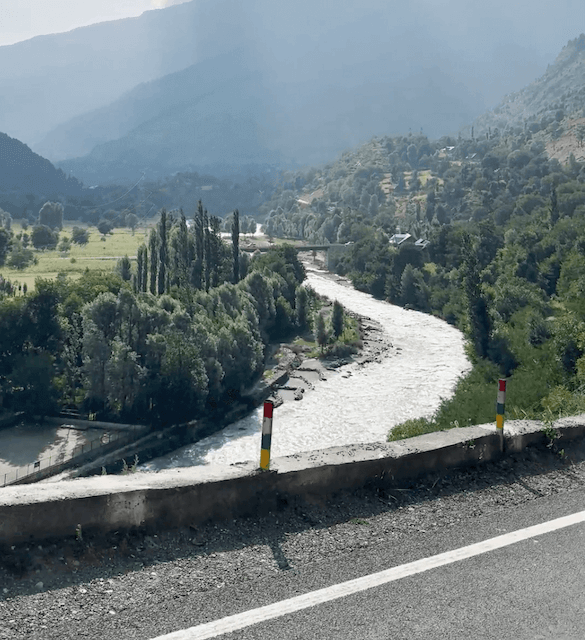
We made a pit stop near Dal Lake, waiting for four more trekkers to join our group. After a two-hour wait, we resumed our journey, soaking in the views of beautiful rivers, majestic mountains, and charming local houses along the way. We finally reached Shitkadi camp around 5 pm, where we dropped our backpacks in the tents and went on a quick warm-up hike to acclimatize. Dinner was a delicious spread of paneer, roti, dal, chawal, and papad. With full stomachs, we wrapped up the day and drifted off to sleep, excited for what lay ahead.
Day 2: Trek from Shitkadi Camp to Nichnai Camp (12 km, 8 hours)
The adventure kicks off in Sonamarg, a picturesque town nestled in the Kashmir Valley. Spanning 80 kilometers over 6 to 7 days, the trek takes you from 8,000 to a staggering 13,750 feet.
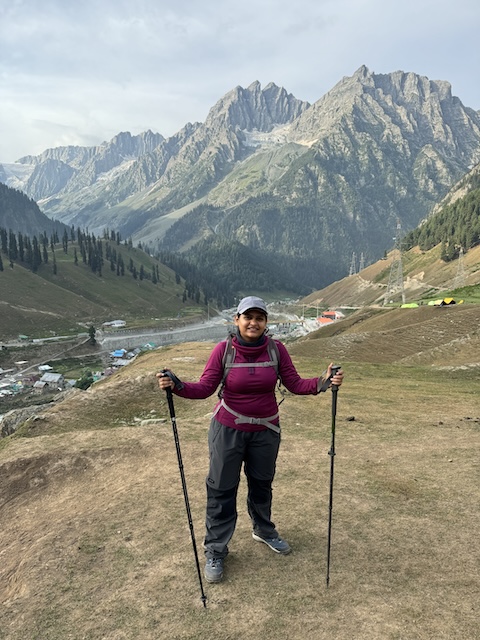
On Day 1, a gentle ascent through dense pine forests offers stunning views of Sonamarg. Frequent breaks allow trekkers to soak in the beauty and savor some warm Maggi and chai. But nature can be unpredictable. Dark clouds rolled in by midday, bringing a downpour. Undeterred, we donned our raincoats and continued the trek.
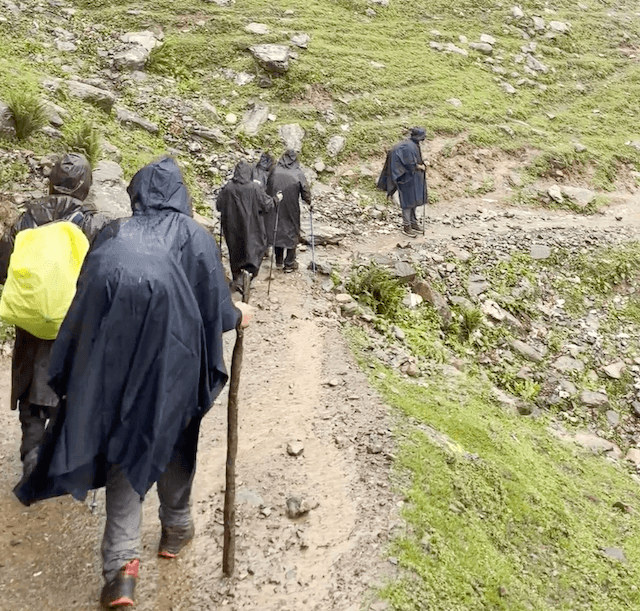
By evening, the skies cleared, revealing a tranquil campsite at Nichnai, where we rested under a canopy of stars.
Day 3: Trek from Nichnai Camp to Vishnusar (Vishansar) Lake (14 km, 8 hours)
Day 3 began early, with a challenging climb over Nichnai Pass. The effort was rewarded with stunning vistas of endless valleys and snow-capped peaks. The descent brought us to lush meadows dotted with wildflowers and grazing sheep—a scene straight out of a postcard.
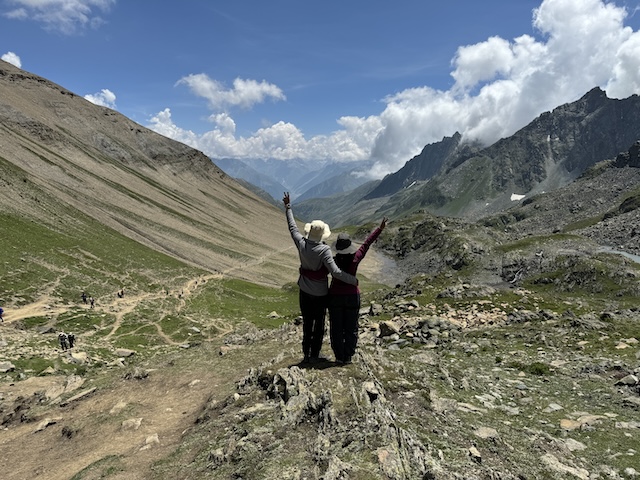
Lunch by a gurgling stream recharged our spirits, and a few more hours of trekking led us to the Vishansar campsite. The clear night sky, adorned with shooting stars and the Milky Way, made for an unforgettable evening.
Day 4: The Toughest Stretch Trek from Vishansar Lake To Gadsar (16 km, 10 hours)
Brace yourself for the longest and most challenging day of the trek. We traversed steep trails, passing the mesmerizing Vishansar and Krishansar Lakes. The arduous climb to Gadsar Pass, the trek’s highest point at 13,750 feet, tested our limits but offered unmatched views of twin lakes and towering peaks.
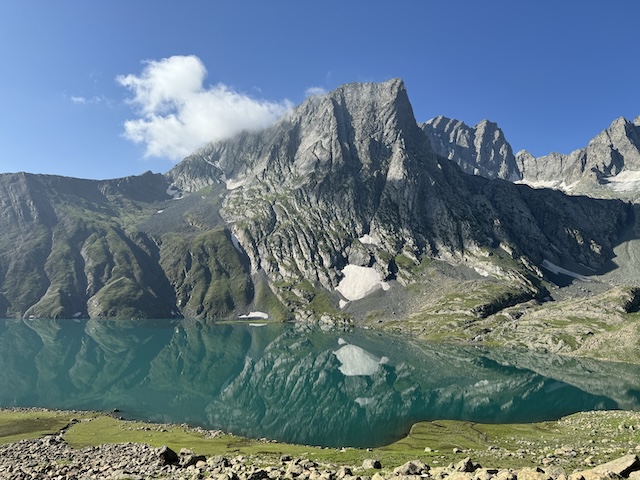
The descent revealed sprawling grasslands and vibrant wildflowers. By the time we reached Gadsar Lake, exhaustion gave way to awe. This sacred, mysterious lake, surrounded by towering mountains, felt like a scene from a dream.
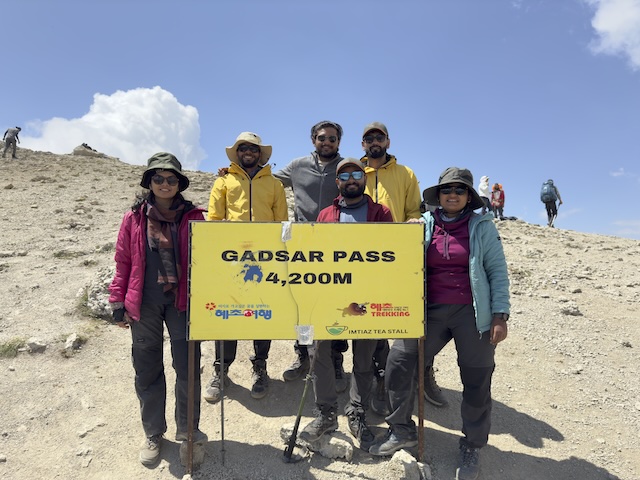
Day 5: Trek from Gadsar to Satsar (12 km, 6 hours)
A shorter, relatively easier day, Day 5 involved crossing a slippery glacier and strolling through grassy landscapes. Tiny wild strawberries along the trail provided delightful snacks.
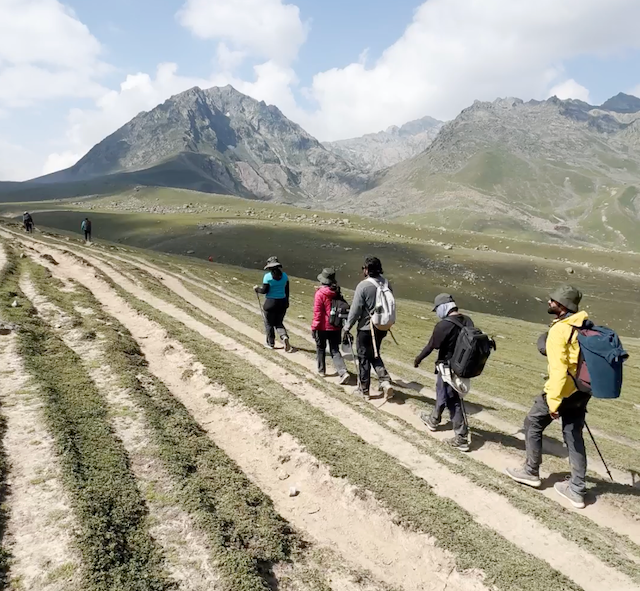
As we approached the Satsar campsite, a series of seven small lakes greeted us, adding to the trek’s magical charm.
Day 6: Trek from Satsar to Nundkol Lake (11 km, 6 hours)
Rain threatened to dampen the day’s journey to Gangbal via Zaj Pass. Navigating tricky boulder sections, we finally reached the pass under cloudy skies.
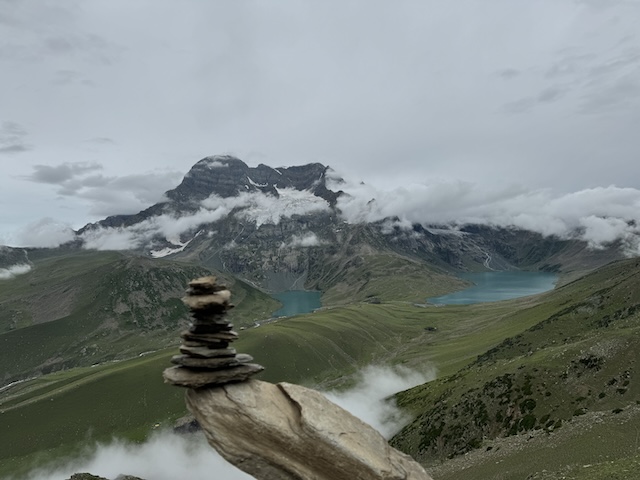
Just as we thought we’d miss the views, the heavens cleared, unveiling the majestic Nundkol and Gangbal Lakes. It was a sight that filled our hearts with gratitude.
Day 7: Buffer Day (Rest Day) – Explore Gangabal Lake (4 km, 3 hours)
Instead of ending the trek, we spent an extra day soaking in the beauty of Gangbal. Exploring the nearby lakes and meadows, we savored the tranquility and splendor of the valley. With no rush, the day was perfect for reflection and appreciation of nature’s grandeur.
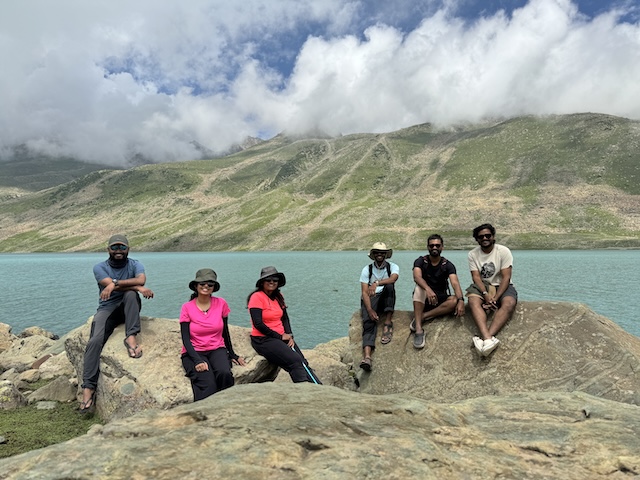
Day 8: The Final Descent: Gangbal to Naranag (15 km, 6 hours)
All good things must come to an end. On Day 8, we descended from Gangbal to Naranag, starting at dawn. The sunrise painted the sky in hues of orange and pink, a fitting farewell to this incredible journey.
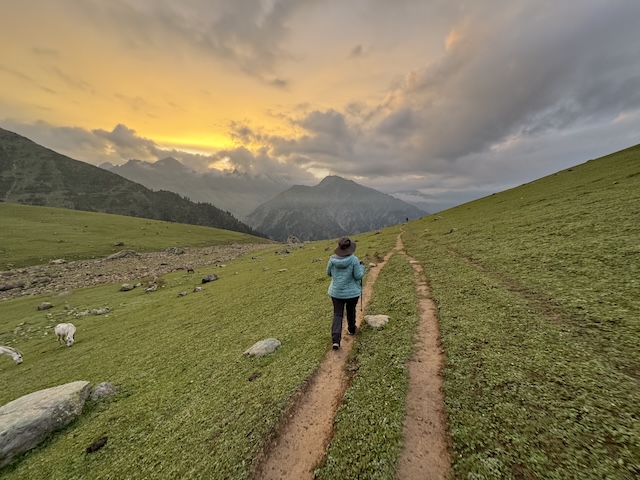
After six hours of trekking, we reached Naranag, marking the end of an adventure that left us humbled and profoundly connected to the natural world.
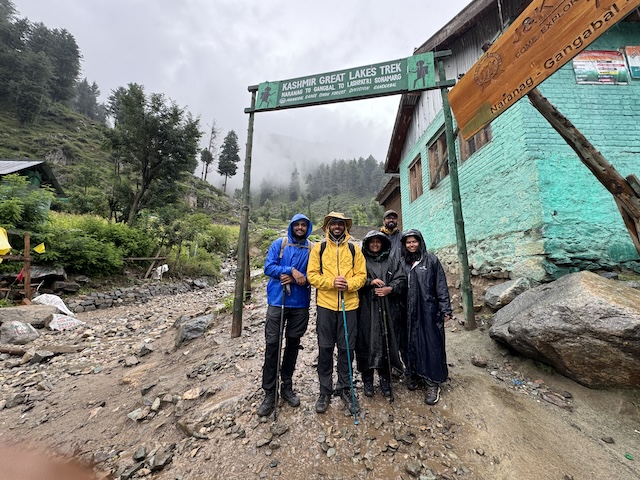
The Kashmir Great Lakes Trek is more than just a hike; it’s a passage into a realm of unparalleled beauty and peace. Each step brought us closer to nature’s wonders—serene lakes, majestic mountains, and whispering winds that seemed to carry ancient tales. This trek is a reminder of the harmony we share with the earth and the boundless beauty it offers. If you’re seeking an adventure that touches your soul, this trek should top your bucket list.
Kashmir Great Lakes Route & Distance
Google Map Link to KGL Trek Route
Below is the detailed route on Google Maps for the Kashmir Great Lakes (KGL) trek provides an essential digital representation of the entire trekking route. This file includes geographical coordinates, elevation profiles, waypoints, and detailed paths for each day’s journey.
Download the Route for Offline Use
For those who prefer offline navigation, you can download the trek route as a KML/KMZ file and use it with GPS apps like Google Earth or other trekking-specific tools. Here’s how:
- Click the Google Map link.
- Go to the three-dot menu in the top-left corner of the map.
- Select Export to KML/KMZ.
- Save the file and upload it to your preferred GPS app.
Recommended Apps for Navigation
- Google Earth: Easily import the KML/KMZ file and view the route in 3D.
- Gaia GPS: Perfect for offline trekking with detailed topographical maps.
- AllTrails: Provides elevation profiles and tracks your progress in real-time.
Preparation for the Trek
Fitness Level
The Kashmir Great Lakes (KGL) trek spans approximately 80 km over 7 days, with altitudes ranging from 8,000 ft to 13,750 ft. A moderate to high level of fitness is essential to enjoy the journey without strain. We began preparing two months prior by gradually increasing our running distance from 1.5 km to 5 km, aiming to complete 5 km within 35 minutes. Additionally, we started doing hikes in the Sahyadris, such as the Garbett Trek and Tringalwadi Fort, to build endurance and acclimate to varied terrains. To further strengthen our stamina, we incorporated short-distance walks within the city into our routine.
Packing Essentials
Proper packing can make or break a trek. Here’s what we packed:
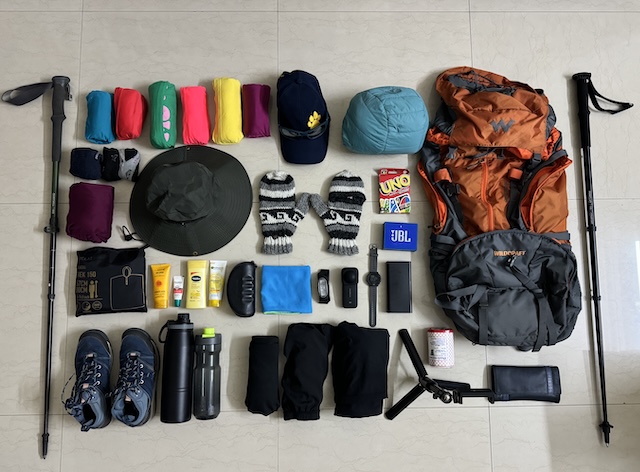
- Clothing: Layered essentials, including thermal wear, quick-dry t-shirts, fleece jackets, a waterproof jacket, and trekking pants.
- Gear: Sturdy trekking shoes, trekking poles, a high-quality backpack, and a rain cover.
- Food: Energy bars, dry fruits, and hydration salts for quick energy and hydration.
- Miscellaneous: Sunscreen, sunglasses, a headlamp, a basic first-aid kit, and personal toiletries.
We prepared a comprehensive checklist and purchased our gear from Decathlon and Amazon to ensure we were well-equipped for the trek.
Permits and Local Regulations
Since the KGL trek requires permits and adherence to local regulations, we booked our trek through Solo Yolo. This group efficiently handled all logistical details, including permits, allowing us to focus entirely on the experience. We made sure to respect the environment by avoiding littering and following Leave No Trace principles to preserve Kashmir’s natural beauty.
Best Time to Visit to KGL Trek
The ideal time to embark on the Kashmir Great Lakes (KGL) trek is between mid-June and early September. During this period, the snow from the winter months has melted, revealing lush meadows and crystal-clear alpine lakes. The temperatures are moderate, ranging from 15°C to 20°C during the day, with cooler nights that dip as low as 3°C to 5°C.
For our trek, we chose the time around 15th August. This decision allowed us to experience Kashmir at its peak vibrancy, with lush landscapes and favorable weather. It also added a patriotic charm, trekking through one of India’s most stunning regions during Independence Day.
Monsoons enhance the beauty of the region, making the landscapes vibrant and the skies dramatic. Trekking during this time ensures an unforgettable experience amidst blooming wildflowers, clear mountain views, and serene lakes.
Must-Have Experiences During Kashmir Great Lakes (KGL) Trek
- Mesmerizing Alpine Lakes
The highlight of the KGL trek is undoubtedly the series of stunning alpine lakes, each more captivating than the last. From the tranquil Vishansar and Krishansar Lakes to the mirror-like Gangbal and Nundkol Lakes, these water bodies offer breathtaking reflections of the surrounding snow-capped peaks. Don’t miss the chance to sit by the lakeside and soak in the serene atmosphere. - Traversing Vibrant Meadows
Walking through the lush green meadows of Nichnai, Satsar, and Gadsar is an experience that feels straight out of a fairytale. These meadows, adorned with colorful wildflowers, provide a stark contrast to the rugged mountain terrain and are perfect for photography or simply basking in the natural beauty. - Challenging Mountain Passes
Crossing high-altitude passes such as Gadsar Pass (13,750 ft) is a thrilling adventure. These sections test your stamina and determination while rewarding you with panoramic views of towering peaks and valleys. - Starlit Nights and Campsites
Camping under the stars at scenic locations like Vishansar Lake or Satsar meadows is an unforgettable experience. The clear skies at high altitudes make for perfect stargazing, with the Milky Way often visible in all its glory. - Cultural Encounters with Locals
Interacting with the local Gujjar and Bakarwal shepherds who traverse these trails is a unique cultural experience. Learning about their nomadic lifestyle and tasting traditional snacks like salted tea and fresh bread add a special touch to the trek. - Sunrise and Sunset Views
Witnessing the sunrise and the golden hues of sunset are magical moments that capture the essence of the trek. Watching the changing hues of the sky reflected on the lakes is a sight to behold.
Challenges Faced and Tips to Overcome Them
- Steep Ascents and Descents
The KGL trek involves navigating challenging terrains, including steep climbs and sharp descents. These can strain your knees and test your balance. Maintain a steady pace, take short breaks when needed, and use trekking poles to reduce the impact on your knees and improve stability. - Unpredictable Weather
Weather in the Himalayas can change rapidly, with sudden rain, strong winds, or a drop in temperature. Always carry rain gear (waterproof jacket and pants) and extra layers to stay dry and warm. Packing quick-dry clothing is essential for comfort. - Physical and Mental Endurance
Covering approximately 80 km over seven days requires both physical stamina and mental resilience. Long hours of trekking can be exhausting, especially on challenging days. Prepare in advance with regular cardio, strength training, and hiking practice. Stay motivated by focusing on the stunning landscapes and celebrating small milestones along the way. - Managing Altitude Sickness
With altitudes reaching up to 13,750 ft, altitude sickness can pose a significant risk, causing headaches, nausea, or fatigue. Acclimatize properly by ascending gradually, staying hydrated, and avoiding overexertion. Listen to your body and communicate any symptoms to your trek leader. - Hydration and Energy Maintenance
Trekking at high altitudes dehydrates the body quickly, and maintaining energy levels is crucial for sustained performance. Drink water frequently, even if you’re not thirsty. Carry energy bars, dry fruits, and hydration salts to replenish lost nutrients and keep your energy up. - Respecting Local Culture and Environment
The trek passes through remote areas inhabited by local shepherds and pristine natural landscapes that must be preserved. Be respectful to locals by interacting courteously and following their customs. Practice Leave No Trace principles by carrying your trash, avoiding damage to flora and fauna, and staying on marked trails.
FAQs for the Kashmir Great Lakes (KGL) Trek
- What kind of accommodation is available during the trek?
Tents are provided at designated campsites, offering a cozy and comfortable shelter amidst nature. - What will the temperatures be like?
Daytime temperatures range from 15°C to 20°C, while nights can get chilly, often dropping to 0°C or lower. - Where and when do we meet in Srinagar?
Your trek operator will provide the specific meeting point and time, usually at a centrally located hotel or landmark in Srinagar. - How do we reach the base camp and return after the trek?
Transportation to and from the base camp is typically arranged by the trek operator as part of the package. - What is the best time to do the KGL trek?
The best time is July to September, when the snow has melted, the weather is favorable, and the meadows and lakes are at their most vibrant. - Is KGL a good trek for a first-timer?
Though moderately challenging, it is suitable for first-timers with basic fitness and some prior hiking experience. - Is there mobile network on the trek?
There is limited to no network throughout the trek. Jio or BSNL post-paid connections may work sporadically in certain areas. - Are there electricity charging points or ways to charge devices?
No, there are no charging points. The trek is in remote areas without electricity. Carry a fully charged power bank (20,000–30,000 mAh) for your devices. Frequent trekkers may also invest in a solar power bank. - Is a trekking pole necessary?
A trekking pole is highly recommended for added stability and reducing strain on your knees during steep ascents and descents. - Can I do the KGL trek solo?
Solo trekking is not advisable due to permits and safety considerations in Kashmir. Trekking in a group ensures safety and simplifies logistics. - Is it safe to trek in Kashmir?
Yes, it is safe as long as you follow your guide’s instructions, respect local regulations, and avoid venturing off marked trails. - What kind of food can we expect?
The crew serves a variety of delicious, freshly prepared vegetarian meals:
Breakfast: Bread, eggs, poha, or upma.
Lunch: Packed meals like rice or stuffed parathas.
Snacks: Pakoras (fritters) and hot tea upon reaching the campsite.
Dinner: A wholesome spread of rice, roti, dal, two vegetables, salad, and dessert.
Occasionally, special treats like puri-bhaji and chole-bhature are served.